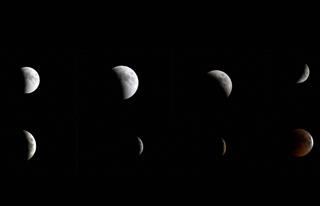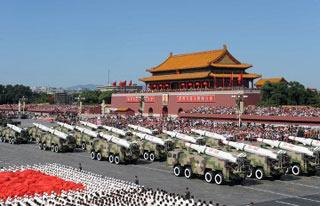
A sequence of photos shows various stages of a partial lunar eclipse over Srinagar on Thursday. Photo: PTI.
NEW DELHI (PTI): Stunning shades of orange and red flitted across the sky as the Moon dipped into the Earth's shadow leaving celestial observers captivated at the spectacle in the wee hours on Wednesday.
Thousands of sky enthusiasts across the country gathered under the open skies, on roof tops and at planetariums to see the total lunar eclipse, which was the century's longest and darkest.
In a clear sky over the national capital, the full moon slowly slipped into the earth's darker shadow starting just after 22:54:34 PM.
As the moon's bright white glow gave way to a coppery, luminescent orange, amateur astronomers armed with telescopes and cameras camped at the Nehru Planetarium here and took photographs of the celestial phenomenon.
"It was a great experience. I took the photographs and they are simply amazing," Prateek, an amateur astronomer said.
Nisha Gupta, a school teacher, said, "I have never seen a total eclipse like this. I was left speechless."
The total phase of the eclipse lasted 100 minutes. The last eclipse to exceed this duration was in July 2000, Nehru Planetarium Director N Rathnasree told PTI.
The next such eclipse will only take place in 2141.
The penumbral lunar eclipse began at 22:54:34 IST and ended at 04:30:45 IST, she said.
The total lunar eclipse began at 00:52:30 IST and ended at 02:32:42 IST. While the partial eclipse began at 23:52:56 IST and ended at 03:32:15 IST.
As the earth came in between the Sun and the Moon, its shadow first began sweeping across the moon blocking out much of its bright light and as the shadow descended gently, the Moon's face turned red.
A lunar eclipse occurs when the Earth in course of its orbit around the Sun, comes between the Moon and Sun in such a way that Moon is hidden in the shadow cast by Earth.
This can occur only when the Sun, Earth, and Moon are aligned in a straight line, C B Devgun from Science Popularisation Association of Communicators and Educators (SPACE) said.
People living in eastern Africa, the Middle East, central Asia and western Australia were also able to watch the entire eclipse, from beginning to end, Arvind Paranjpye, scientific officer of Inter-University Centre for Astronomy and Astrophysics, said.
At mid-eclipse, the Moon was overhead at Mauritius.
Observers in eastern Brazil, Uruguay and Argentina also witnessed the totality. However, the eclipse was not visible from North America, he said.
The eclipse was also one of the darkest due to the ashes thrown into the Earth's atmosphere by the recent eruption of Iceland's most active volcano, Grimsvotn, he said.
The magnitude of the eclipse was 1.70 magnitude, N Sri Raghunandan Kumar of Planetary Society of India said.
Also, a star named 51 Ophiuchi was occulted during the eclipse.
At 11:29 PM, the Moon occulted (hide) behind the star 51 Ophiuchi. The star reappeared after 90 minutes at 01:01 AM of June 16, Kumar said.
 Previous Article
Previous Article Next Article
Next Article












The Indian Air Force, in its flight trials evaluation report submitted before the Defence Ministry l..
view articleAn insight into the Medium Multi-Role Combat Aircraft competition...
view articleSky enthusiasts can now spot the International Space Station (ISS) commanded by Indian-American astr..
view article